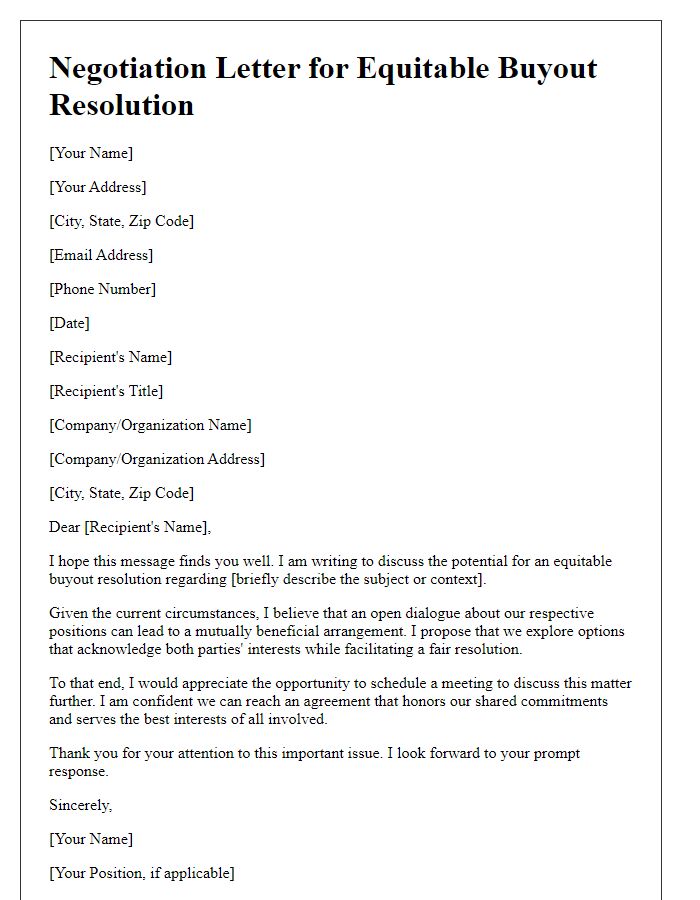Are you navigating the complex waters of partnership equity buyout negotiations? If so, you know that clear communication and understanding are key to a successful outcome. In this article, we'll explore effective strategies and provide a comprehensive letter template to help you articulate your proposal with confidence. So, grab a cup of coffee and let's dive into the details to ensure your negotiation process is as smooth as possible!

Current Value Assessment
A partnership equity buyout negotiation must begin with a thorough current value assessment of the business entity, such as a limited liability corporation (LLC) or partnership firm. This assessment takes into account tangible assets, including real estate, equipment, and inventory, alongside intangible assets like brand reputation, customer relationships, and intellectual property. A representative valuation method, such as the discounted cash flow analysis, is crucial to project future profits and account for potential market fluctuations. Adjustments to this valuation may be necessary, factoring in liabilities such as outstanding debts and obligations, which could total tens of thousands of dollars. By collecting historical financial data and potential growth forecasts, stakeholders prepare for negotiations that reflect both present capital and growth potential, along with equity stakes that may vary significantly - typically between 10% to 50% of ownership. Being equipped with a clear understanding of the business's current financial health ensures all parties engage in a fair, informed negotiation process.
Equity Share Breakdown
In partnership equity buyout negotiations, understanding the equity share breakdown is essential for both parties. The total ownership structure often includes various stakeholders, such as a 60% share held by the founding partners and a 40% share comprised of minority investors. The valuation of the business, for instance, may be established at $1 million, leading to individual share values of $600,000 for founding partners and $400,000 for minority investors. Key considerations involve the negotiation of buyout prices based on projected future earnings, market conditions, and the company's growth trajectory. Effective communication about each partner's contribution to profits, losses, and decision-making responsibilities ensures a smooth negotiation process. Additionally, legal frameworks governing partnership agreements, such as state-specific Uniform Partnership Act provisions, must be scrutinized to ensure compliance and fairness.
Payment Terms and Conditions
A partnership equity buyout negotiation often involves detailed payment terms and conditions, impacting both financial strategy and business operations significantly. Key aspects include the purchase price valuation method, commonly using methodologies such as discounted cash flow (DCF), market comparables, or asset-based approaches, ensuring fair compensation reflecting actual business worth. Payment terms might involve structured payments, often tailored over, for example, 12 months, allowing gradual transfer of equity while ensuring cash flow stability. Additionally, consideration of earn-out clauses can align interests, providing sellers potential bonuses linked to future performance metrics, fostering goodwill. Legal documentation, typically required during the negotiation, ensures compliance and protection for all parties, mitigating risks associated with the transfer process.
Future Financial Projections
Future financial projections for a business partnership typically involve a comprehensive analysis of expected revenue, operating expenses, and net profit over a set period, often spanning five years. For instance, if a tech startup currently generates $1 million in annual revenue, an average annual growth rate of 20% could result in projected revenue of approximately $2.49 million by the fifth year. Operating expenses could remain at 60% of revenue, totaling around $1.49 million, thus leading to an estimated net profit of $996,000 by year five. Furthermore, factors such as market trends, competitive analysis, and potential economic challenges should be taken into account to create a realistic projection model. A well-defined strategy outlining key performance indicators (KPIs) and anticipated milestones would also enhance the credibility of the financial forecast.
Legal and Tax Implications
Partnership equity buyouts involve intricate legal and tax implications, requiring careful consideration of agreements, valuations, and regulatory compliance. The Partnership Agreement outlines the terms for the buyout process, including notice periods and buyout valuations based on fair market value or specific formulas. Legal implications, such as potential litigation risks from non-compliance, must be assessed thoroughly. Tax implications arise from capital gains taxes triggered by the sale of equity interests, which can vary by jurisdiction--for instance, federal rates in the United States can range from 0% to 20% based on income levels. Adequate planning can mitigate tax burdens, potentially through strategies like installment sales or structure adjustments to minimize tax exposure. Consulting with legal and tax professionals is essential for navigating these complexities effectively.













Comments